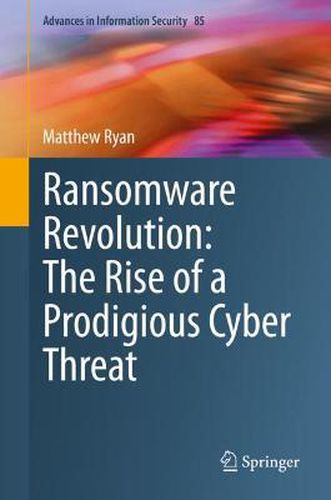Readings Newsletter
Become a Readings Member to make your shopping experience even easier.
Sign in or sign up for free!
You’re not far away from qualifying for FREE standard shipping within Australia
You’ve qualified for FREE standard shipping within Australia
The cart is loading…






This title is printed to order. This book may have been self-published. If so, we cannot guarantee the quality of the content. In the main most books will have gone through the editing process however some may not. We therefore suggest that you be aware of this before ordering this book. If in doubt check either the author or publisher’s details as we are unable to accept any returns unless they are faulty. Please contact us if you have any questions.
This book explores the genesis of ransomware and how the parallel emergence of encryption technologies has elevated ransomware to become the most prodigious cyber threat that enterprises are confronting. It also investigates the driving forces behind what has been dubbed the ‘ransomware revolution’ after a series of major attacks beginning in 2013, and how the advent of cryptocurrencies provided the catalyst for the development and increased profitability of ransomware, sparking a phenomenal rise in the number and complexity of ransomware attacks.
This book analyzes why the speed of technology adoption has been a fundamental factor in the continued success of financially motivated cybercrime, and how the ease of public access to advanced encryption techniques has allowed malicious actors to continue to operate with increased anonymity across the internet. This anonymity has enabled increased collaboration between attackers, which has aided the development of new ransomware attacks, and led to an increasing level of technical complexity in ransomware attacks. This book highlights that the continuous expansion and early adoption of emerging technologies may be beyond the capacity of conventional risk managers and risk management frameworks.
Researchers and advanced level students studying or working in computer science, business or criminology will find this book useful as a reference or secondary text. Professionals working in cybersecurity, cryptography, information technology, financial crime (and other related topics) will also welcome this book as a reference.
$9.00 standard shipping within Australia
FREE standard shipping within Australia for orders over $100.00
Express & International shipping calculated at checkout
This title is printed to order. This book may have been self-published. If so, we cannot guarantee the quality of the content. In the main most books will have gone through the editing process however some may not. We therefore suggest that you be aware of this before ordering this book. If in doubt check either the author or publisher’s details as we are unable to accept any returns unless they are faulty. Please contact us if you have any questions.
This book explores the genesis of ransomware and how the parallel emergence of encryption technologies has elevated ransomware to become the most prodigious cyber threat that enterprises are confronting. It also investigates the driving forces behind what has been dubbed the ‘ransomware revolution’ after a series of major attacks beginning in 2013, and how the advent of cryptocurrencies provided the catalyst for the development and increased profitability of ransomware, sparking a phenomenal rise in the number and complexity of ransomware attacks.
This book analyzes why the speed of technology adoption has been a fundamental factor in the continued success of financially motivated cybercrime, and how the ease of public access to advanced encryption techniques has allowed malicious actors to continue to operate with increased anonymity across the internet. This anonymity has enabled increased collaboration between attackers, which has aided the development of new ransomware attacks, and led to an increasing level of technical complexity in ransomware attacks. This book highlights that the continuous expansion and early adoption of emerging technologies may be beyond the capacity of conventional risk managers and risk management frameworks.
Researchers and advanced level students studying or working in computer science, business or criminology will find this book useful as a reference or secondary text. Professionals working in cybersecurity, cryptography, information technology, financial crime (and other related topics) will also welcome this book as a reference.